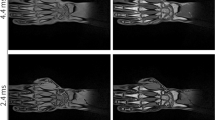Abstract
The values of in vivo T1 relaxation time (T1) of phosphorus atoms of wrist bone have been measured by phosphorus-31 magnetic resonance spectroscopy (MRS) in 65 menopausal women separated into three groups: (1) agematched women without any paraclinical or clinical osteoporosis; (2) patients with paraclinical osteoporosis detected only by dual photonic absorptiometry; and (3) women with clinical osteoporosis with vertebral fractures. No significant differences were found in T1 values in the presence of paraclinical or clinical osteoporosis as compared to control values. No relationships were found among the T1, the value of the Z-score, the value of bone mineral content, the age of patients, the number of their children, and the age of menopause. Phosphorus-31 magnetic resonance spectroscopy of the wrist fails to separate osteoporotic from nonosteoporotic women and cannot be clinically used at this time to perform a noninvasive diagnosis of osteoporosis.
Similar content being viewed by others
References
Hall FM, Davis MA, Baran DT (1987) Bone mineral screening for osteoporosis. N Engl J Med 316(4):212–214
Sartoris DJ, Resnick D (1989) Dual-energy radiographic absorptiometry for bone densitometry: current status and perspective. Am J Roentgenol 152:241–246
Bottomley PA (1989) Human in vivo NMR spectroscopy in diagnostic medicine: clinical tool or research probe. Radiology 170:1–15
Roufosse AH, Aue WP, Roberts JE, Gimler MJ, Griffin RG (1984) Investigation of the mineral phases of bone by solid-state phosphorus-31 magic angle spinning nuclear magnetic resonance. Biochemistry 23:6115–6120
Brown CE, Battocletti JH, Srinivasan R, Moore J, Sigmann P (1987) In vivo 31P NMR spectroscopy for evaluation of osteoporosis. Lancet 4:37–38
Brown CE, Battocletti JH, Srinivasan R, Moore J, Sigmann P (1988) In vivo 31P nuclear magnetic resonance spectroscopy of bone mineral for evaluation of osteoporosis. Clin Chem 34(7):1431–1438
Riggs LB, Melton LJ (1986) Involutional osteoporosis. N Engl J Med 314(26):1676–1686
Nordin BEC (1987) The definition and diagnosis of osteoporosis. Calcif Tissue Int 40:57–58
Ackerman JL, Garrido L, Moore JR, Pfleiderer B, Wu Y (1992) Fluid and solid state MRI of biological and nonbiological ceramics. In: Blumich B, Kuhn (eds) Magnetic resonance microscopy: methods and applications in material science, agriculture and biomedicine. VCH Publishers Weinheim, New York, USA, p 237
Cleveland S, McGill R (1983) Graphical perception and graphical methods for analyzing scientific data. Science 229:828–833
Dolecki M, Sashin D, Mosher T, Herndon JH, Smith M (1990) A phosphorus NMR spectroscopy for measuring bone density. In vitro and in vivo studies. In: Proc. Society of Magnetic Resonance in Medicine, 9th annual meeting, New York, p 1229
Meunier PJ (1990) Bone quality versus bone quantity. In: Nordin BEC (ed) Osteoporosis: contribution to modern management. Parthenon Publishing, Park Ridge, New Jersey, USA, p 31
Bendahan D, Confort-Gouny S, Kozak Ribbens G, Cozzone PJ (1993) Investigation of metabolic myopathies by P-31 MRS using a standardized rest-exercise-recovery protocol: a survey of 800 explorations. MAGMA 1:91–104
Ott SM, Kilcoyne RF, Chesnut CH (1988) Comparisons among methods of measuring bone mass and relationship to severity of vertebral fractures in osteoporosis. J Clin Endocrinol Metab 66:501–507
Werhli FW, Forf JC, Hsiao-Wen C, Werhli SL, Williams JL, Grimm MJ, Kugelmass SD, Jara (1993) Potential role of nuclear magnetic resonance for the evaluation of trabecular bone quality. Calcif Tissue Int 53 (suppl 1):S162-S169
Chung H, Werhli FW, Williams JL, Kugelmass SD (1993) Relationship between NMR transverse relaxation, trabecular bone density and strength. Proc Natl Acad Sci USA 90:10250–10254
Confort-Gouny S, Vion-Dury J, Cozzone PJ (1992) Méthodes de localisation du signal de RMN in vivo. Vers une approche métabolique des pathologies. J Radiol (Paris) 73(1):13–21
Ford JC, Wehrli FW (1991) In vivo quantitative characterization of trabecular bone by NMR interferometry and localized proton spectroscopy. Magn Reson Med 17:543–551
Ebifegha ME, Code RF, Harisson JE, McNeill KG, Szyjkowski M (1987) In vivo analysis of bone fluoride content via NMR. Phys Med Biol 32(4):439–451
Ackerman JL, Raleigh DP, Glimcher MJ (1992) Phosphorus-31 magnetic resonance imaging of hydroxyapatite: a model for bone imaging. Magn Reson Med 25:1–11
Author information
Authors and Affiliations
Rights and permissions
About this article
Cite this article
Confort-Gouny, S., Mattéi, J.P., Vion-Dury, J. et al. Phosphorus-31 in vivo magnetic resonance spectroscopy of bone fails to diagnose osteoporosis. Calcif Tissue Int 56, 529–532 (1995). https://doi.org/10.1007/BF00298583
Received:
Accepted:
Issue Date:
DOI: https://doi.org/10.1007/BF00298583




